Article's Content
Ever wondered what the ROI of social selling on LinkedIn is? You’ll see the numbers shortly.
But first, Dreamdata.
So, on February 23, 2022, I was diving deep into a case study on a marketing website when I stumbled again on Dreamdata. Previously, I had seen some employee posts on this B2B revenue attribution platform and my gut told me to check them out.
What I found blew me away.
You know, everyone who’s been in B2B long enough knows that acquiring B2B leads is a hard nut to crack, even on LinkedIn. But when you attract your ideal prospects without spending ad dollars, it becomes a thing of beauty.
That’s exactly what Dreamdata does by making employee advocacy the core of their LinkedIn social selling strategy.
According to Hootsuite, social selling is the practice of using a brand’s social media channels to connect with prospects, develop a connection with them, and engage with potential leads. While connecting with prospects via a brand account is good, connecting through the content from employees’ accounts is even better.
Here’s why:
- Employee networks have 10x more connections than their company’s followers (LinkedIn)
- Content shared by employees receives 8x more engagement than content shared by brand channels (Social Media Today)
- Employee content can generate 5x more website traffic and 25 percent more leads (Inc)
- By 2023, 90% of B2B social media marketing strategies will incorporate scaled employee advocacy programs (Gartner)
All of these stats prove that the main driver of social selling engines are no longer brand accounts, but employee accounts.
So, What is Employee Advocacy?
Employee advocacy is an internal culture where workers actively promote their organization to build relationships and attract their ideal customers. While your team can do this both offline and online, social media proves to be the most cost-effective channel for running employee advocacy programs. And brands like Dreamdata can attest to this.
Consistent employee advocacy helped 6 Dreamdata employees build a social selling engine that saves an average of $5.26 per click and $6.59 per 1000 impressions on LinkedIn.
At 520,447 views by the end of their LinkedIn campaign, these employees had saved their company a boatload of money that would’ve been spent on LinkedIn ads.
I mean, see their LinkedIn social selling scorecard in just 91 days:
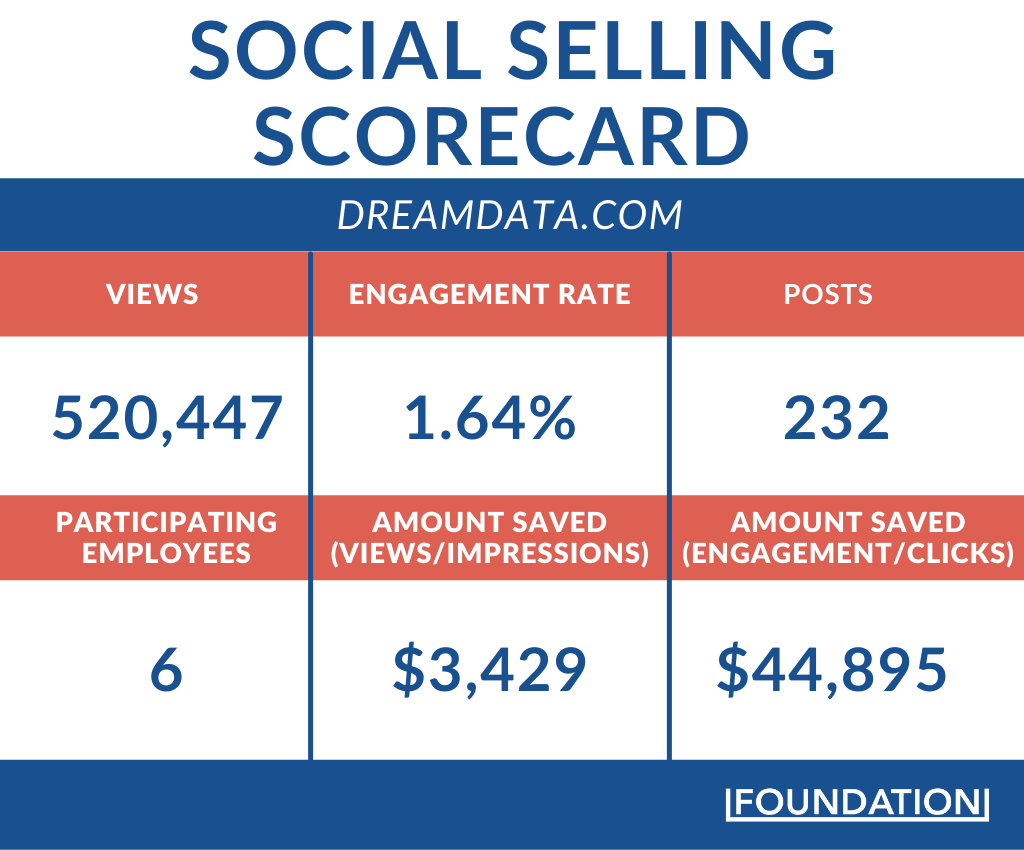
Impressive, right?
But there’s more.
By continuing with the same LinkedIn playbook for one year, these 6 employees would have provided about $200,000 worth of value for Dreamdata.
Munch on that for a second … $200,000.
Dreamdata would have to spend this exact amount to get similar views and engagement like their employees did throughout the year. And considering that Dreamdata’s product is priced at $749 per month (the cheapest option aside from the free plan), a 1% conversion rate from those engaging with the employees’ content would be a gamechanger, especially if the average customer lifespan is up to 12 months.
Now that you know what the ROI of social selling on LinkedIn looks like, I’m sure you have lots of questions.
- How did Dreamdata do it?
- How did they track the data?
- How did they know what to post?
- How did they realize the value of social selling?
- How did they attract the right people to their content?
- How can I encourage my employees to adopt a social selling strategy on LinkedIn?
These are excellent questions and we’ll answer them all.
** But before we dive in, we’ve created a template that will help you and your team step on the gas and get your social selling engine running. It’s the exact template we use at Foundation. Get it here 👉 LinkedIn Social Selling Content Template.
That said, let’s uncover how Dreamdata built its social selling moat.
Dreamdata’s LinkedIn Strategy Was Lit by One Post
Yes, one post. That’s all it took Dreamdata’s LinkedIn social selling engine to power up. And this post didn’t take hours to write. It was a simple story turned viral post of how Laura Erdem, Dreamdata’s Account Executive, closed a contract with a fantastic client.
Laura didn’t expect much engagement since she usually got just a few reactions and comments on her posts. A quick look at the LinkedIn reactions and comments from Laura’s last five posts gives credence to this line of thought.
Here’s what the engagement of Laura’s last 5 posts looked like:
| Post | Reactions | Comments |
|---|---|---|
| Post 5 | 11 reactions | 0 comments |
| Post 4 | 16 reactions | 5 comments |
| Post 3 | 12 reactions | 0 comments |
| Post 2 | 27 reactions | 2 comments |
| Post 1 | 11 reactions | 0 comments |
You would expect the next post to have no more than 50 reactions and maybe 20 comments, right? Nope!
Instead of settling for a measly engagement rate, Laura’s next post set LinkedIn on fire and attracted 378 reactions and 83 comments. This sudden spike in reactions and comments wasn’t by accident. It happened because the post attracted a single comment from Chris Walker, a marketing influencer on LinkedIn, who currently has 89,000+ followers. Chris’s comment was enough to trigger the LinkedIn algorithm to show the post to more relevant people who fit Dreamdata’s ideal customer profile.
The result?
- The post had more than 40,000 views
- The Dreamdata website had its best-ever day in terms of visitors
- Dreamdata had the most marketing qualified leads ever
These kinds of results can quickly build up an adrenaline rush of excitement that could propel a brand to go into pitching mode with those who engaged with their viral content.
But no, Dreamdata wasn’t going to do that.
In Laura’s words:
“We were very excited and torn between two options. Should we go and contact all the likers and commenters with a Dreamdata pitch, or should we let it go and wait for them to come to us organically?
We chose not to pitch, but to connect with everyone who engaged with the post. And by continuously building messages in the same field, a lot of the prospects started to organically ask for demos or trial accounts.”
To keep the demo and free trial requests coming in, 6 members of the Dreamdata team decided to double down on LinkedIn after seeing the success of Laura’s post. So they created a simple goal 👉 If they hit 300,000 views of their combined posts in Q2, they’d be treated to a team dinner at the end of the quarter.
That’s it.
It was a simple goal that was completely based on experimentation.
There was no roadmap on how they’d get there.
But eventually, they did, and almost 2x their goal with 520,447 views by the end of the quarter.
Let’s take a look at the kind of content that worked for Dreamdata.
How Dreamdata Executes their LinkedIn Social Selling Strategy
Hop on Trending Topics
Marketers who use LinkedIn daily will tell you that these topics are not new to their feed:
- SEO is dead
- email is dead
- to gate or ungate
- remote work
- remote vs hybrid work
And so many more.
These are trending topics that attract lots and lots of reactions because people either relate to them or have strong diverse views about them.
Take this post on remote work by Steffen Hedebrandt, for instance. Remote work is an idea that an increasing number of employees want. So this topic is sure to spark engagement.
How about the post structure? It’s very interesting.
A quick look at the lede hints that this captivating post speaks to two of Dreamdata’s ICPs:
- Marketers who are new to remote and started working remotely when the pandemic hit
- Remote work OGs who would like to learn more about Steffen’s remote work story
Now aside from that, Steffen leveraged a popular name (Tim Ferris), who has over 1.5 Million followers. Remember the comment by Chris Walker that caused Laura’s post to snowball with a ton of engagement? The same could happen here if Tim engaged with Steffen’s content.
Away from Steffen’s content, how about this post by Laura Erdem on a tug-of-war-styled topic — to gate or not to gate? This topic gets lots of engagement because marketers exist on either side of the divide who strongly believe that content should remain gated or ungated. Even Lars, Dreamdata’s CEO, has strong opinions on this topic.
What’s even more interesting about how the Dreamdata team hops on trends is their drive to continuously distribute the trendy content that gained traction. And this leads us to the next point.
Embracing Content Distribution on LinkedIn
Marketers often think of content distribution in terms of blog content. While this thinking is in line, it’s also worth knowing that you can distribute all of your content assets (including social content) in multiple formats provided they’ve been proven to drive engagement. This is something the Dreamdata team executes well.
For instance, this post on gating vs ungating content shows Laura Erdem building anticipation for a LinkedIn live session she intends to run with her CEO. This post was created a week before the live session. The post engagement? 100 reactions and 16 comments.
But Laura wasn’t done. Rather than pat herself on the back for a good engagement rate on a simple announcement, Laura built more anticipation by talking again about the LinkedIn live session. This time the engagement rate was still up at 61 reactions and 35 comments.
All of these posts built anticipation for the live event and over 100 people attended.
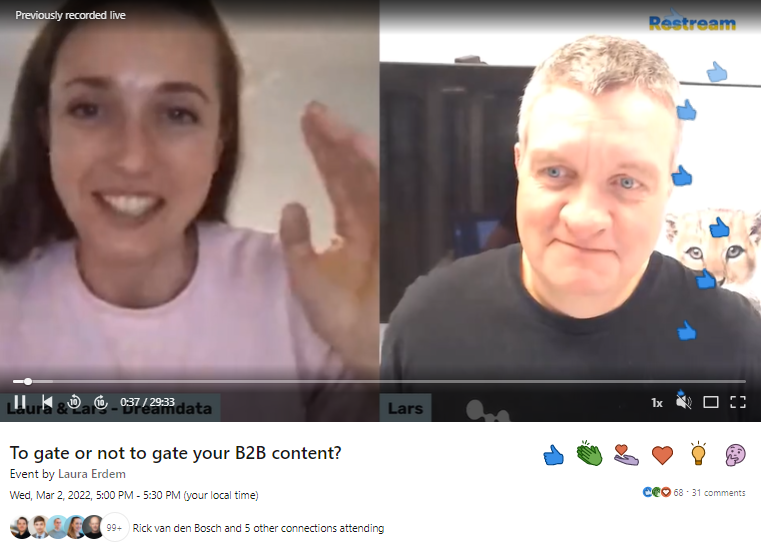
At this point, you’d think Dreamdata was done talking about gating content.
Nah.
A week later, Laura talked about it some more.
Adopting this strategy is simple. You only need to repurpose your thoughts on the topic into different content formats. For Laura, this was video, GIF, live session, and finally, a text post.
And you don’t need to worry that some of your connections will think you’re repeating your ideas.
First off, it’s worth knowing that many of your LinkedIn posts are seen by only 20-25% of your followers. Therefore, distributing your content in more formats gives it exposure to your followers who haven’t seen it.
Likewise, you could have 2,000 followers today and 4,000 followers in 5 months’ time. There’s a good chance that 95% of your new followers won’t bother scrolling down your LinkedIn activity to read your posts from 5 months ago. In other words, these people won’t read or watch your great content from months ago if you fail to re-share it.
Experimentation Culture
If there’s one thing the Dreamdata team digs into very well, it’s experiments. One of the results of embracing experimentation culture is this very post you’re reading. By doing a social selling experiment, the Dreamdata team caught my attention, I wrote about them, you’re reading about them, they have acquired a free backlink from this post, and you could decide to become their client.
All this from experimentation!
When doing experiments on LinkedIn or any other marketing channel, embrace the fact that you could fail.
In the words of Jeff Bezos, “The most important inventions come from trial and error with lots of failures.”
Failing can help you learn something new. And you don’t need to keep these failures to yourself. Just as you share your successes, share your failures, as well. This helps you alert your audience about strategies or tactics that may not work.
Your audience wants to know what you got right, what went south, and what you’re improving on. Writing about your wins and losses will get you more mindshare, people will know about your product, they’ll engage and connect with you, and they could become clients down the line.
Entertain with Memes That Tell a Relatable Story
Statistics show that LinkedIn is the #1 professional networking platform. There’s no doubt that it’s true, but it’s not all suits and ties. LinkedIn users also catch fun on Twitter, Instagram, Snapchat, etc. Dreamdata employees know this. That’s why they inject personality into their content with memes and it works like magic. Pure online abracadabra.
Check out this impressive post that tells a relatable story of how every new connection feels on LinkedIn. The meme is so spot on. And the post lede is straight to the point. The result? 2500 reactions, 145 comments, and 64 shares. That’s pure gold considering the number of eyeballs that will see this post and learn about Dreamdata.
What I find even more interesting about Samuel Malpiedi’s profile is his number of followers. At just 2,025 followers, his post reach is stunning.
And you see a similar reach with Samuel’s other memes. Here’s Samuel’s engagement scorecard from some of his recent memes.
| Post | Reactions | Comments |
|---|---|---|
| Post 1 | 629 reactions | 59 comments |
| Post 2 | 46 reactions | 6 comments |
| Post 3 | 34 reactions | 1 comment |
| Post 4 | 1043 reactions | 103 comments |
Have I mentioned that one of Samuel’s posts reached 680,000 people? That’s right. 680,000 views on one post with just 2,025 followers. Bravo. All it takes to start creating viral memes like this is to understand your audience deeply and use a meme generator.
Embracing Video Content Production
In the words of Adam Mosseri, the Head of Instagram:
“There’s some really serious competition right now. TikTok is huge. YouTube is even bigger, and there are many other video platforms. Videos are driving an immense amount of growth online for all the major platforms right now, and it’s one that I think we need to lean into more.”
Aside from TikTok, YouTube, and Instagram, a professional platform like LinkedIn won’t sleep on this video trend. They could be all-in on it and use their algorithm to boost the post-reach of video content from creators. Also, video content is great for engaging even your laziest followers because they reduce the cognitive processing of information.
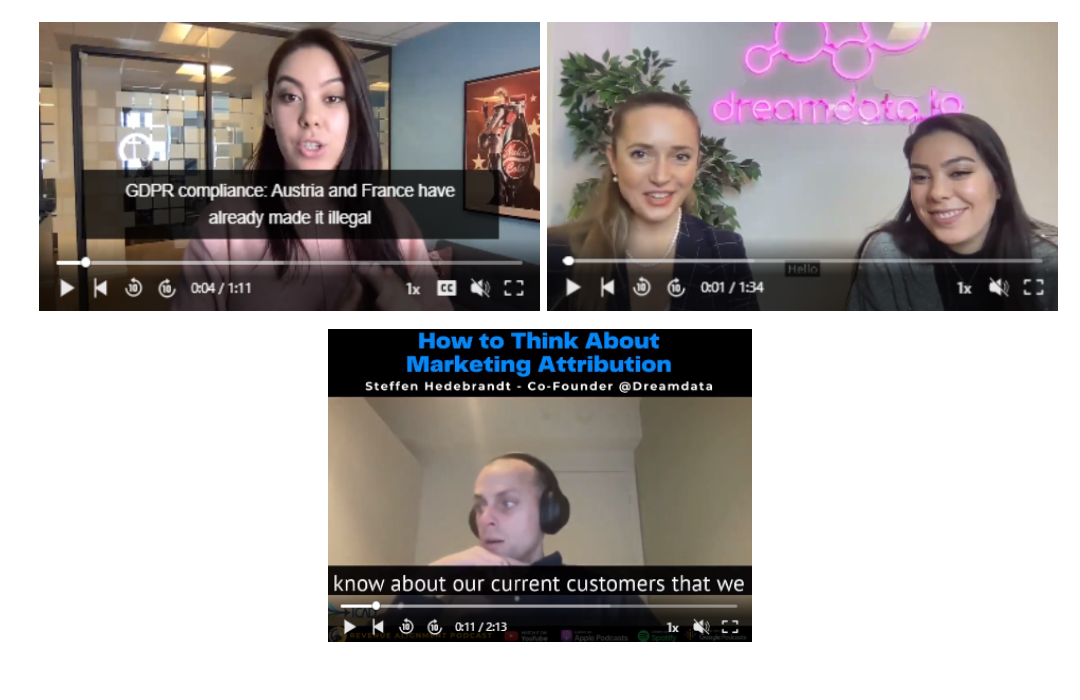
B2B brands like Dreamdata have included video marketing in their LinkedIn strategy and this is a smart marketing play by many of their employees. As they feed the shifting consumer appetite from text posts to video posts, they get paid with more engagement, more mindshare, more qualified leads, and so on.
Show Social Proof
When you look at Bill.com, ShipBob, and many other B2B websites, you’ll see something similar — they all use solid social proof on their websites. But on LinkedIn, not so much.
See, you can create all the content you want on LinkedIn, attract a ton of engagements, and yet some of your ideal prospects won’t budge. These prospects need hardcore evidence that your product works. That’s where social proof really shines on LinkedIn.
And this proof doesn’t need to come from influencer brands or individuals. They could be simple email screenshots like this one that reads, “We are a competitor of Dreamdata. We want to understand your use cases that they solve and what you find helpful/unique in Dreamdata.”
This is great social proof that your product works because you keep your competitors thinking about how to outshine you.
You can also use screenshots of your G2 reviews.
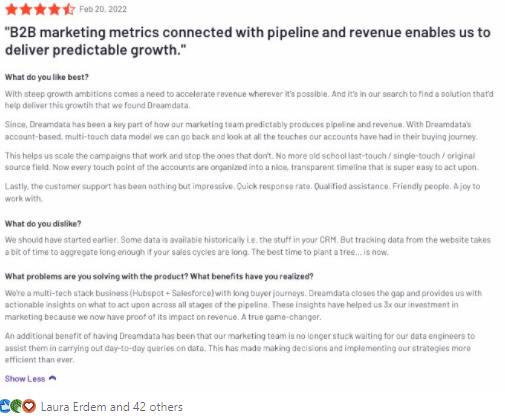
Or listen to what people say about your product and talk about it.
Someone raving about your product is also social proof. Use all of these to position your brand as a market leader.
Repurposing a Teammate’s Content
Foundation is not just a big believer in content distribution, we also focus on repurposing to give every piece of content a chance to gain more eyeballs.
A piece of content might fail on Twitter, TikTok, and Pinterest but succeed on LinkedIn.
On LinkedIn, this means you can repurpose your text posts into memes, videos, GIFs, images, illustrations, and more. Continuously repurposing your content into different formats could help you find a format that resonates with your audience.
In the words of Ines Ben Farhat:
“You can have completely different results if you change the format of your post.”
So, don’t allow a teammate’s content to go to waste.
Grab ‘em and repurpose them.

Finding Your ICPs to Engage with Your LinkedIn Content
One of the easiest ways to create unproductive LinkedIn content is to connect with every Tom, Dick, and Harry. More connections may result in more engagement but more engagement doesn’t always mean more ROI. This is something we see with the Dreamdata team as they mostly connect with those who fit into their ICP.
So, how do you identify your own ICP?
Enter a documented content strategy.
Having a documented content strategy gives you insights into the roles of those you want to help.
And if you don’t know how to find your ICPs on LinkedIn, here are some starting points:
- Connect with the people who engage with industry influencers’ posts.
- Find niche Slack groups, engage with those you want to connect with, and send them a connection request on LinkedIn. Engaging first in a Slack group makes your name memorable and the chances of them rejecting your request are reduced.
- Conduct LinkedIn and Zoom live events. These events attract a community of like-minded folks so it makes sense to connect with them if the theme of the discussion aligns with your product.
What to Avoid When Building Your LinkedIn Social Selling Engine
There are numerous pitfalls to watch out for when you intend to create content that drives demand on LinkedIn. Here are some to consider:
- Always talking about your product: Talking about your product on every LinkedIn post won’t get you your desired results. Instead of doing that, focus on your customers’ pain points and create content (in multiple formats) that addresses how your product might help them with their challenges.
- Linking to your blog content every time: The LinkedIn algorithm is not a fan of content that moves its audience away from its platform. I’ve tested this multiple times both on my personal account and client accounts. Posting blog links every time just doesn’t work. Stay away from it. It’s hugely ineffective.
- Failing to track results: Not tracking your results is a recipe for not knowing what to improve. But before you even track those results, you need to set personal goals for your team and yourself. These goals could include an increase in follower count, brand visibility that results in podcast and video interviews, increased revenue, and more.
- Inconsistency with your social selling strategy: Success has always been built on the back of consistency. And like everything you do, you’ll need consistency to make social selling work hard for you. Even when the results aren’t what you expect, keep posting and learn from the process.
How to Build Your LinkedIn Social Selling Engine
If you want to steadily march towards your LinkedIn goals without any obstruction, you’ll need to follow some ground rules like these:
- Create flexible goals: Your goals on LinkedIn should be simple. For Dreamdata, the goal was to hit 300,000 views. Yours could be to get “X” number of podcast features per quarter, have “X” number of followers within a period, acquire “X” number of leads, and so on.
- Create a content idea bank: Your content bank should have ideas that your team can use when their creative juices aren’t flowing. These ideas should cover pain points related to your ICPs. For instance, a content bank for a marketing agency would include topics like content marketing, brand positioning, content intelligence, and more.
- Communicate often: Encourage team members to always communicate by sharing their wins, blockers, learnings, and LinkedIn marketing tools they use. This will motivate the team to get what they need and drive them to continue posting and engaging on LinkedIn.
- Have a team hashtag: Support is key when running social selling programs with your team. And having a team hashtag makes it easy for your team members to support each other’s posts. For example, at Foundation we use #shapeculture as our branded hashtag to find and engage with the posts of everyone on our team.
Think About Your LinkedIn Posting Cadence
Many people get LinkedIn posting wrong when they post links, links, and more links to their content. Dreamdata didn’t do this, we don’t do this at Foundation, and we don’t encourage it.
Instead of posting links, have a posting cadence that looks like this:
- Monday – Post to direct readers to your blog
- Tuesday – Post a fun meme related to your industry to create engagement
- Wednesday – Post to direct readers to your blog
- Thursday – Run a useful poll
- Friday – Write a one-liner post
- Saturday – Talk about something related to your company – news, pictures, client shoutout, testimonial screenshots, or behind the scenes of how you work
- Sunday – Write a valuable post and deliberately tag accounts with whom you have a shared audience
How to Get Employees to Adopt a LinkedIn Social Selling Strategy
Sow the Idea
If you have employees or new hires who use LinkedIn in a way you resonate with, ask them to share their ideas with the team. This was what our CEO, Ross Simmonds, did when I joined Foundation.

The result of this nudge was a 30-day posting sprint that has helped many Foundationites to take a shot at building their personal brand on LinkedIn.
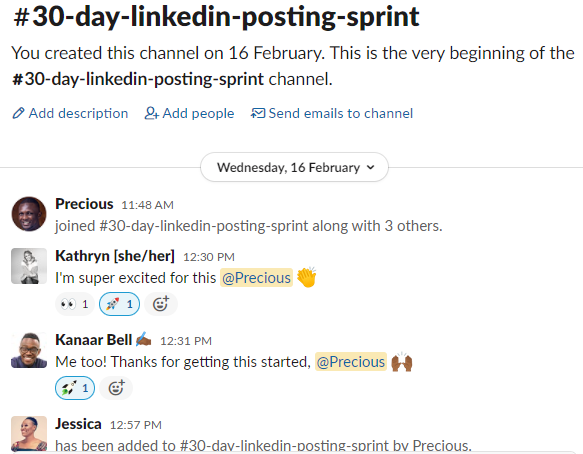
Continuously Talk about Social Selling
Zoom calls, Slack, and email conversations are great opportunities to drive home your social selling message to your team. Where possible, you can even use blog posts like Ross did by writing two posts on how Gong and Outreach built their LinkedIn social selling moats. All of these non-pushy strategies lay the foundation that your team needs to power up their LinkedIn game.
And sometimes the results don’t take long to pour in. In fact, on the first day of our 30-day posting sprint, I got motivated to write and publish something after seeing one of our team member’s posts. Turns out that post is one of my best performing with over 20,000 views!
It can be very powerful when your team comes together to make LinkedIn work.
Provide a Great Working Environment
No one wants to dump their personal brand and adopt your company background photo on LinkedIn if the job isn’t worth it. Having a uniform LinkedIn background photo like Dreamdata is akin to waving the flag of your company on every post, comment, and reaction.

So strive to make your organization comfortable for your employees because that’s the only way to keep them focused on engaging and producing quality content that drives real demand for your company. If they’re happy to work there, it will shine through in all of their posts and interactions, and you can’t fake genuine enthusiasm.
The Ugly Aspect of Social Selling
👉 Employee attrition.
Once employees start posting on LinkedIn, there’ll be no shortage of job offers and side gigs.
As Lars G. Hansen said:
“Putting your team out there allows them to build up so much personal brand and capital that they get approached every day with super exciting job offers.”
And Lars is right. For instance, Laura Erdem, Dreamdata’s account executive, has job offers flooding her DMs.
But rather than opting for those jobs that she could easily get, here’s what Laura says:
“I truly believe in what we are building at Dreamdata and this early high-growth company possibility does not happen that often, therefore I choose to stay here. It is an extremely strong founders team that has a lot of trust in the startup world.”
Laura goes on to say that:
“Employers who adopt social selling must trust employees building their brand in public that they are not just going to promote your company, but will also choose to stay”!
But staying at a company doesn’t come cheap. It comes from a place of employee happiness and an environment that’s packed with growth opportunities.
So do your company a favor by keeping your team happy and providing room for growth. Happiness isn’t only about good pay. You need to care for your employees’ wellbeing, adopt fully remote or hybrid work, provide tech budgets, have good perks and benefits, and so on.
These levers will encourage your team to stay regardless of the numerous poachers trying to woo them in their LinkedIn DMs.
Wrapping Up
Social selling on LinkedIn doesn’t have to be hard once you appreciate the ROI involved.
You retain all the money you’d have spent on ads.
You gain an insane amount of mindshare.
You build a lot of buzz about your brand.
You drive real product demand.
Here’s a recap on how to approach social selling:
- Hop on trending topics
- Embrace content distribution
- Dig into experiments
- Use multiple content formats – videos, text posts, memes, GIFs, illustrations
- Show social proof
- Encourage team content repurposing
- Connect with more of your ICPs
- Track your results
- Create a great working environment so employees really love your brand
Last but not least, make sure to grab your LinkedIn Social Selling Content Template so that your employees can easily navigate social selling and generate demand and revenue for your brand.







